Text and pictures by Jeremy Stafford-Deitsch
Underwater photographer and author, Jeremy Stafford-Deitsch, has made a study of sharks from many parts of the world. Shark: A Photographer's Story, was a best selling book in which he recounted his personal experiences of diving with sharks. In this pictorial essay, written exclusively for Arabian Wildlife, he has drawn together the main species to be found in Arabian waters. Like many divers, Jeremy is a strong believer in shark conservation, believing that our fear of sharks has led us to ignore the unique role they play in the ocean's ecosystem, and the need for them to be conserved rather than hunted to extinction. Jeremy is presently writing a book on the rich variety of life associated with mangroves.
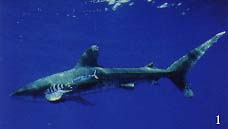 1. The oceanic whitetip, Carcharhinus longimanus, is master of the vast apparent emptiness of the open ocean. As such it is rarely seen by divers unless they are specifically seeking it out. It has been suggested that the splotchy white fin markings act as a lure, drawing inquisitive fishes in close enough to be eaten. Oceanic white-tips are occasionally encountered off open water reefs in the Red Sea - for instance the Brothers (El Akhawein) in the Egyptian Red Sea. This is a bold and powerful shark: it will readily swim up to, and bump a diver in order to investigate a potential food source. As such it is obviously dangerous. Underwater photographers who wish to photograph this shark must have a boat nearby for rapid exit after the pictures have been taken!
1. The oceanic whitetip, Carcharhinus longimanus, is master of the vast apparent emptiness of the open ocean. As such it is rarely seen by divers unless they are specifically seeking it out. It has been suggested that the splotchy white fin markings act as a lure, drawing inquisitive fishes in close enough to be eaten. Oceanic white-tips are occasionally encountered off open water reefs in the Red Sea - for instance the Brothers (El Akhawein) in the Egyptian Red Sea. This is a bold and powerful shark: it will readily swim up to, and bump a diver in order to investigate a potential food source. As such it is obviously dangerous. Underwater photographers who wish to photograph this shark must have a boat nearby for rapid exit after the pictures have been taken!
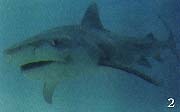 2. The tiger shark, Galeocerdo cuvier, grows to an immense size - six metres or more. Its huge mouth and bluntly serrated teeth allow it to tackle virtually anything edible that it encounters. Because the tiger shark can bite chunks out of food items too large to swallow whole, it is a very dangerous shark and has been implicated in many attacks on humans. Fortunately the tiger shark tends to spend the daylight hours in deep water so rarely encounters humans. However, at night it is known to enter shallow water and so may be considered potentially dangerous to night divers on coral-reefs.
2. The tiger shark, Galeocerdo cuvier, grows to an immense size - six metres or more. Its huge mouth and bluntly serrated teeth allow it to tackle virtually anything edible that it encounters. Because the tiger shark can bite chunks out of food items too large to swallow whole, it is a very dangerous shark and has been implicated in many attacks on humans. Fortunately the tiger shark tends to spend the daylight hours in deep water so rarely encounters humans. However, at night it is known to enter shallow water and so may be considered potentially dangerous to night divers on coral-reefs.
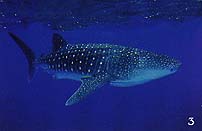 3. The whale shark, Rhincodon typus, is the largest shark, indeed fish, in the sea. It attains twelve metres (perhaps considerably more) in length and is occasionally encountered in the Red Sea. It feeds mainly on zooplankton and is more likely to be found in areas where this is particularly rich. It may be attracted towards coral reefs when mass coral spawning occurs. It is capable of considerable curiosity and will swim up to divers to take a closer look at them.
3. The whale shark, Rhincodon typus, is the largest shark, indeed fish, in the sea. It attains twelve metres (perhaps considerably more) in length and is occasionally encountered in the Red Sea. It feeds mainly on zooplankton and is more likely to be found in areas where this is particularly rich. It may be attracted towards coral reefs when mass coral spawning occurs. It is capable of considerable curiosity and will swim up to divers to take a closer look at them.
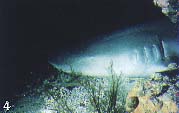 4. The tawny shark, Nebrius ferrugineus, is a bottom dwelling shark of coral reefs. It is nocturnal and spends the day hidden under coral heads. At night it hunts crustaceans and octopus as well as hoovering up any sleeping fish it encounters.
4. The tawny shark, Nebrius ferrugineus, is a bottom dwelling shark of coral reefs. It is nocturnal and spends the day hidden under coral heads. At night it hunts crustaceans and octopus as well as hoovering up any sleeping fish it encounters.
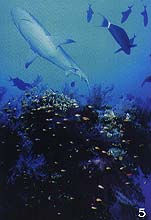 5. The grey-reef shark, Carcharhinus amblyrhynchos, is often seen by divers on Red Sea reefs. It grows to about one and three-quarter metres in length and, while it usually keeps its distance from divers, it can be inquisitive and even aggressive if harassed. Grey reef sharks usually hunt at dawn or dusk, frequently in groups. I have seen several grey reef sharks actively drive a school of black surgeonfish against the reef wall in order to feed on them.
5. The grey-reef shark, Carcharhinus amblyrhynchos, is often seen by divers on Red Sea reefs. It grows to about one and three-quarter metres in length and, while it usually keeps its distance from divers, it can be inquisitive and even aggressive if harassed. Grey reef sharks usually hunt at dawn or dusk, frequently in groups. I have seen several grey reef sharks actively drive a school of black surgeonfish against the reef wall in order to feed on them.
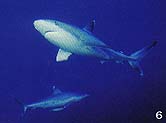 6. Silvertip sharks, Carcharhinus albimarginatus, are commonly encountered off open water reefs in the central Red Sea. Like many shark species of the Red Sea, it may be that they are more common in the summer months. Silvertips are normally encountered deep down on the current-buffeted points of offshore reefs. They are swift, powerful and magnificently patterned. Silvertips can grow to three metres or more. Large individuals can be aggressive and are potentially dangerous. Once they reach over two and a half metres silvertips put on bulk and are often heavily scarred around the head - suggesting a change of diet from open water fishes to bottom dwelling creatures, such as stingrays, that must be prized from the reef floor.
6. Silvertip sharks, Carcharhinus albimarginatus, are commonly encountered off open water reefs in the central Red Sea. Like many shark species of the Red Sea, it may be that they are more common in the summer months. Silvertips are normally encountered deep down on the current-buffeted points of offshore reefs. They are swift, powerful and magnificently patterned. Silvertips can grow to three metres or more. Large individuals can be aggressive and are potentially dangerous. Once they reach over two and a half metres silvertips put on bulk and are often heavily scarred around the head - suggesting a change of diet from open water fishes to bottom dwelling creatures, such as stingrays, that must be prized from the reef floor.
 7. The silky shark, Carcharhinus falciformis, is a thin, streamlined shark of the open water. It is occasionally encountered by divers off the edges of oceanic reefs. This two metre silky was photographed in fifty metres of water off Elphin-stone Reef in the Egyptian Red Sea. Note the tiny juvenile pilot fish riding the pressure wave in front of the shark's snout.
7. The silky shark, Carcharhinus falciformis, is a thin, streamlined shark of the open water. It is occasionally encountered by divers off the edges of oceanic reefs. This two metre silky was photographed in fifty metres of water off Elphin-stone Reef in the Egyptian Red Sea. Note the tiny juvenile pilot fish riding the pressure wave in front of the shark's snout.
 8. The shortfin mako, Isurus oxyrhinchus, is an underwater cheetah. It feeds on the swiftest open water fishes such as tunas. It is hardly ever seen by divers as it tends to swim away from reefs. A miniature version of the great white shark, the shortfin mako grows to some four metres in length, and is dangerous. One is known to have attacked a swimmer in the Red Sea.
8. The shortfin mako, Isurus oxyrhinchus, is an underwater cheetah. It feeds on the swiftest open water fishes such as tunas. It is hardly ever seen by divers as it tends to swim away from reefs. A miniature version of the great white shark, the shortfin mako grows to some four metres in length, and is dangerous. One is known to have attacked a swimmer in the Red Sea.
 9. The zebra shark, Stegostoma fasciatum, is a common bottom-dwelling shark on Indian ocean reefs, such as along the coast of Oman, and also occurs in the Red Sea. It feeds mainly on molluscs though it will also take shrimps, lobsters and crabs as well as bony fishes and octopus. During the day it is usually found at rest on the sea-bed.
9. The zebra shark, Stegostoma fasciatum, is a common bottom-dwelling shark on Indian ocean reefs, such as along the coast of Oman, and also occurs in the Red Sea. It feeds mainly on molluscs though it will also take shrimps, lobsters and crabs as well as bony fishes and octopus. During the day it is usually found at rest on the sea-bed.
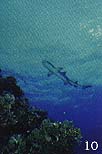 10. The white-tip reef shark, Triaenodon obesus, is a small and inoffensive shark common on Red Sea reefs. During the day it can be found at rest on the sea-floor or swimming slowly along the reef. At night it becomes more active and will force its way into coral crevices in search of sleeping fishes.
10. The white-tip reef shark, Triaenodon obesus, is a small and inoffensive shark common on Red Sea reefs. During the day it can be found at rest on the sea-floor or swimming slowly along the reef. At night it becomes more active and will force its way into coral crevices in search of sleeping fishes.
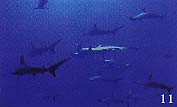 11. There are few more exciting sights for a diver than a school of scalloped hammerhead sharks, Sphyrna lewini. The scalloped hammerhead is the most common of the nine species of hammerhead and has a pan-oceanic distribution. In many parts of the world scalloped hammerheads form large schools. This is by no means unknown off Red Sea reefs where this picture was taken early in the morning. Hammerhead schools are often at considerable depths of fifty metres or more and filming such schools is a considerable challenge.
11. There are few more exciting sights for a diver than a school of scalloped hammerhead sharks, Sphyrna lewini. The scalloped hammerhead is the most common of the nine species of hammerhead and has a pan-oceanic distribution. In many parts of the world scalloped hammerheads form large schools. This is by no means unknown off Red Sea reefs where this picture was taken early in the morning. Hammerhead schools are often at considerable depths of fifty metres or more and filming such schools is a considerable challenge.
Arabian Wildlife. Volume 1, Number 1